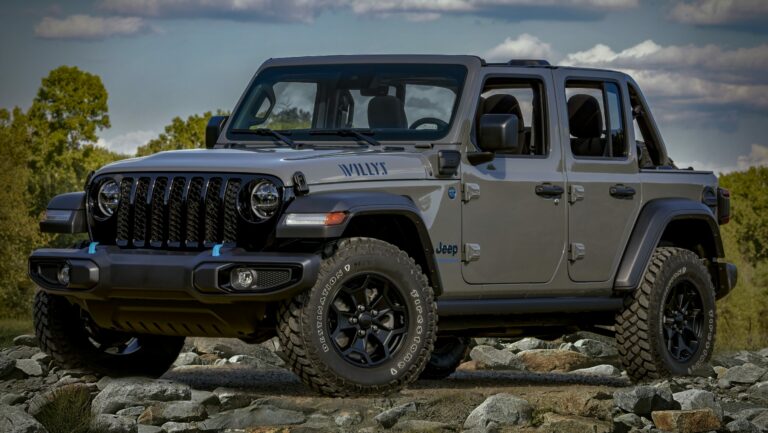1955 Jeep For Sale: A Comprehensive Buyer’s Guide
1955 Jeep For Sale: A Comprehensive Buyer’s Guide jeeps.truckstrend.com
Introduction: Embarking on the Quest for a 1955 Jeep
The phrase "1955 Jeep For Sale" conjures images of rugged individualism, timeless design, and a direct connection to a pivotal era in automotive history. More than just a vehicle, a 1955 Jeep represents a piece of Americana, a testament to utilitarian design, and an enduring symbol of off-road capability. For enthusiasts, collectors, or even those simply seeking a unique classic vehicle, finding a 1955 Jeep for sale is not merely a transaction; it’s the beginning of an adventure into restoration, preservation, or simply enjoying a piece of functional history.
1955 Jeep For Sale: A Comprehensive Buyer’s Guide
In 1955, Willys Motors (soon to become Kaiser Jeep) was at a fascinating crossroads, transitioning from the iconic CJ-3B "high hood" to the introduction of the more modern, yet equally rugged, CJ-5. This makes the 1955 model year particularly interesting for buyers, offering a glimpse into both the past and the future of the civilian Jeep. This comprehensive guide aims to equip potential buyers with the knowledge and insights necessary to navigate the exciting, yet often challenging, world of acquiring a 1955 Jeep for sale.
The Enduring Legacy: Why 1955 Was a Pivotal Year for Jeep
To truly appreciate a 1955 Jeep for sale, one must understand its historical context. The Jeep’s lineage traces back to the wartime MB, a vehicle that proved indispensable during WWII. After the war, Willys-Overland (later Willys Motors) adapted this military marvel for civilian use, giving birth to the "Civilian Jeep" or CJ series.
The year 1955 is significant because it marked a transition point. While the CJ-3B, introduced in 1953, with its distinctive taller hood to accommodate the Hurricane F-head engine, was still in production, 1955 also saw the debut of the CJ-5. The CJ-5 was a more refined, slightly larger, and longer-lived design, based on the M38A1 military Jeep. This dual offering means that when you search for a "1955 Jeep for sale," you might encounter either a CJ-3B or an early CJ-5, each with its own unique characteristics and appeal.
These vehicles were not built for luxury; they were built for work. From agricultural applications and construction sites to remote exploration, the 1955 Jeep was a versatile workhorse that cemented its reputation for reliability and go-anywhere capability. Its simplicity of design and robust mechanicals contributed to its longevity, making it a viable and sought-after classic vehicle even today.
Key Models and Specifications of the 1955 Jeep
Understanding the specific models and their core specifications is crucial when evaluating a 1955 Jeep for sale.
-
Willys CJ-3B:
- Engine: Willys F4-134 Hurricane I4 engine (2.2L, F-head, ~75 hp). This engine is known for its torque at low RPMs and robust construction.
- Transmission: Borg-Warner T-90 3-speed manual.
- Transfer Case: Dana 18 two-speed (high/low range, 2WD/4WD).
- Axles: Dana 25 or Dana 27 front, Dana 44 rear.
- Distinguishing Feature: The "high hood" design, necessary to clear the taller Hurricane engine. This gives the CJ-3B a unique, somewhat quirky, appearance compared to its predecessors.
- Production: Continued from 1953 through 1968, though 1955 models are early examples.
-
Willys CJ-5:
- Engine: Primarily the Willys F4-134 Hurricane I4 engine. Some later models in its long production run would get the V6.
- Transmission: Borg-Warner T-90 3-speed manual.
- Transfer Case: Dana 18 two-speed.
- Axles: Dana 25 or Dana 27 front, Dana 44 rear.
- Distinguishing Feature: A more modern, rounded body style, longer wheelbase than the CJ-3B, and slightly wider stance. This design would largely define the CJ series for the next 30 years.
- Production: Began in 1955 and continued until 1983, making the 1955 CJ-5 an early and desirable example of a very successful model line.

Both models share common characteristics like solid axles, leaf spring suspension, and a minimalist interior, emphasizing their utility over comfort. When considering a 1955 Jeep for sale, identifying whether it’s a CJ-3B or an early CJ-5 is the first step in understanding its originality and potential value.
Why Invest in a 1955 Jeep? Benefits and Appeal
The decision to purchase a 1955 Jeep for sale goes beyond mere transportation. It’s an investment in a lifestyle and a piece of history.
- Classic Vehicle Status: These Jeeps are undeniably classic. Their iconic shape and historical significance make them stand out at car shows or simply cruising down the road.
- Off-Road Prowess: Despite their age, 1955 Jeeps, especially well-maintained ones, retain impressive off-road capabilities. Their light weight, short wheelbase, and robust 4×4 system make them surprisingly agile on trails.
- Simplicity of Mechanics: With minimal electronics and straightforward mechanical systems, 1955 Jeeps are relatively easy to work on for the DIY enthusiast. Parts are generally available (or can be fabricated), and repair manuals are plentiful.
- Strong Community Support: The Jeep community, especially for vintage CJs, is vast and passionate. Forums, clubs, and specialized vendors offer a wealth of knowledge, advice, and parts.
- Potential for Appreciation: Well-preserved or expertly restored vintage Jeeps can appreciate in value, making them not just a hobby but potentially a sound investment.
- Nostalgia and Character: Owning a 1955 Jeep is a nostalgic experience. It’s a tangible link to a bygone era, offering a raw, unfiltered driving experience that modern vehicles simply can’t replicate.
Important Considerations Before Buying a 1955 Jeep For Sale
Before diving headfirst into the market for a 1955 Jeep for sale, prospective buyers should consider several key factors to ensure a satisfying purchase.
- Condition is King: Rust is the primary enemy of vintage Jeeps. Thoroughly inspect the frame, hat channels (crossmembers under the body), body mounts, and floorboards. A rusty frame can be a deal-breaker or a very costly repair. Also, assess the engine’s health (smoke, leaks, knocking), transmission, transfer case, axles, and electrical system.
- Originality vs. Modifications: Decide whether you want an unmolested, original specimen (which often commands a higher price) or a modified "restomod" that might offer better modern drivability or off-road performance. Many old Jeeps have had engine swaps, suspension upgrades, or other modifications.
- Documentation: A clear title is paramount. Beyond that, look for any service records, restoration receipts, or historical documents that can verify the vehicle’s provenance and maintenance history.
- Intended Use: Will this be a show vehicle, a weekend off-roader, a parade cruiser, or a full-blown restoration project? Your intended use will dictate the acceptable level of condition and modification. A project vehicle will be cheaper upfront but demand significant time and financial investment.
- Parts Availability: While many parts for CJ-3Bs and CJ-5s are available through specialty vendors, some specific or original parts can be harder to source. Be prepared for some hunting or fabrication.
- Mechanical Aptitude: Owning a vintage Jeep often requires a degree of mechanical sympathy and willingness to learn. If you’re not mechanically inclined, factor in the cost of professional classic car mechanics.
Where to Find a 1955 Jeep For Sale: A How-To Guide
Finding the right 1955 Jeep for sale requires patience and knowing where to look.
- Online Marketplaces:
- Specialized Classic Car Sites: Hemmings.com, ClassicCars.com, BringATrailer.com (for higher-end, well-documented vehicles), eBay Motors (can be a mixed bag).
- General Classifieds: Craigslist (local searches can yield hidden gems, but exercise caution), Facebook Marketplace (often good for local finds and community recommendations).
- Jeep-Specific Forums and Classifieds: Websites like CJ-3B.info, eWillys.com, and various Jeep forums often have classified sections where enthusiasts sell their vehicles.
- Classic Car Auctions: Companies like Barrett-Jackson, Mecum, and smaller regional auctions frequently feature vintage Jeeps. Attending these can give you a sense of market value and allow for in-person inspection.
- Specialty Dealerships and Restorers: Some dealers specialize in vintage 4x4s and may have restored 1955 Jeeps for sale, often at a premium but with a known history and quality of work.
- Word-of-Mouth and Local Searches: Tell friends, family, and local mechanics you’re looking. Check local classifieds, attend local car shows, and even drive through rural areas – you never know what might be sitting in a barn!
- Estate Sales and Auctions: Sometimes vintage vehicles appear at estate sales, often being sold by families who aren’t experts, potentially leading to good deals.
What to Inspect When Viewing a 1955 Jeep For Sale
Once you’ve found a promising 1955 Jeep for sale, a thorough inspection is critical.
- Frame: This is paramount. Look for significant rust, cracks, or poor previous repairs, especially around the spring hangers, crossmembers, and steering box. Tap the frame with a hammer; a dull thud or crumbling metal indicates deep rust.
- Body: Check for rust in the floorboards, cowl, fenders, and tailgate. Look for signs of excessive body filler (bondo) by tapping or using a magnet. Ensure the body mounts are solid.
- Engine: Look for oil leaks. Check the oil color and level. Listen for abnormal noises (knocking, ticking). If possible, perform a compression test. Check for coolant leaks and signs of overheating.
- Drivetrain: Test the transmission (all gears, no grinding). Engage 4WD (high and low range) and ensure the transfer case shifts smoothly. Listen for clunking or grinding from the axles and driveshafts. Check for fluid leaks from differential covers.
- Brakes: Inspect brake lines for rust or damage. Check the brake fluid reservoir. Test the pedal feel (should be firm, not spongy).
- Steering and Suspension: Check for excessive play in the steering wheel. Inspect leaf springs for breaks or sagging. Look at shock absorbers for leaks.
- Electrical System: Test all lights, gauges, and the horn. Look for frayed or aftermarket wiring that could indicate past electrical issues.
- Tires and Wheels: Ensure tires are in good condition with even wear. Check for rusty or bent wheels.
- Test Drive: If possible and safe, take it for a test drive. Listen for unusual noises, feel for vibrations, and assess how it handles turns and stops. Keep in mind it will drive like a 1955 vehicle, not a modern one.
Consider hiring a classic car mechanic for a pre-purchase inspection if you’re not confident in your own assessment, especially for a significant investment.
Restoration vs. Preservation vs. Customization
When you acquire a 1955 Jeep for sale, you typically have three paths:
- Full Restoration: Bringing the vehicle back to original factory specifications, often involving extensive bodywork, engine rebuilds, and sourcing period-correct parts. This is the most expensive and time-consuming option, often yielding the highest value for collectors.
- Preservation: Maintaining the vehicle in its current, original condition, accepting its patina and wear. This focuses on mechanical soundness and preventing further deterioration rather than cosmetic perfection. This is often done for vehicles with low mileage or significant historical provenance.
- Customization/Restomod: Upgrading components for modern drivability, safety, or off-road performance. This could involve engine swaps, disc brake conversions, power steering, or modern suspension. While potentially enhancing usability, it typically reduces "collector" value for purists.
The choice depends on your budget, skills, and ultimate goal for the vehicle.
Potential Challenges and Solutions
Owning a vintage 1955 Jeep for sale isn’t without its challenges, but most have viable solutions.
- Rust: The biggest challenge. Solutions include patch panels, fabricating new sections, or even finding a rust-free donor body/frame. Prevention (garaging, regular cleaning) is key after purchase.
- Parts Scarcity: While many common parts are reproduced, finding specific NOS (New Old Stock) or rare original components can be difficult. Solutions involve joining owner groups, networking with other enthusiasts, and checking specialized salvage yards.
- Mechanical Issues: Older vehicles require more frequent attention. Solutions involve acquiring a good service manual, learning basic mechanics, or finding a reputable classic car mechanic specializing in Jeeps.
- Lack of Modern Safety Features: 1955 Jeeps lack airbags, crumple zones, and advanced braking systems. Drive defensively. Consider adding modern seatbelts, brighter lights, and turn signals for safety. Some owners opt for disc brake conversions.
- Fuel Economy: Don’t expect modern MPG. These vehicles were designed for durability, not efficiency. Plan accordingly for fuel costs.
Price Table: 1955 Jeep For Sale Estimated Value Guide
The price of a 1955 Jeep for sale can vary wildly based on its condition, originality, model (CJ-3B vs. CJ-5), and location. This table provides a general estimate.
| Condition Category | Estimated Price Range (USD) | Key Characteristics |
|---|







